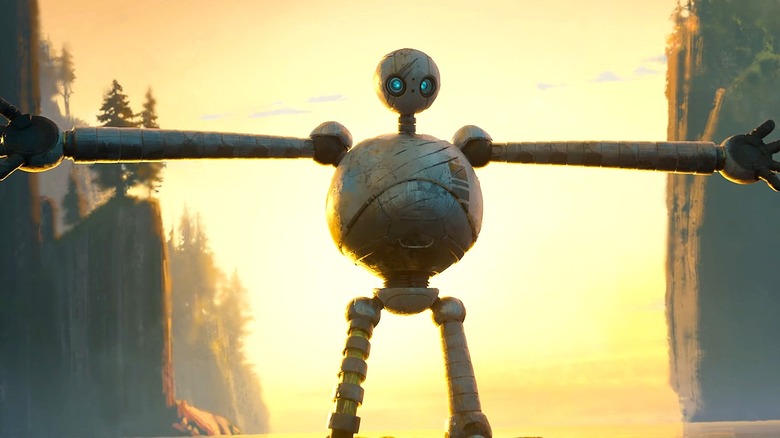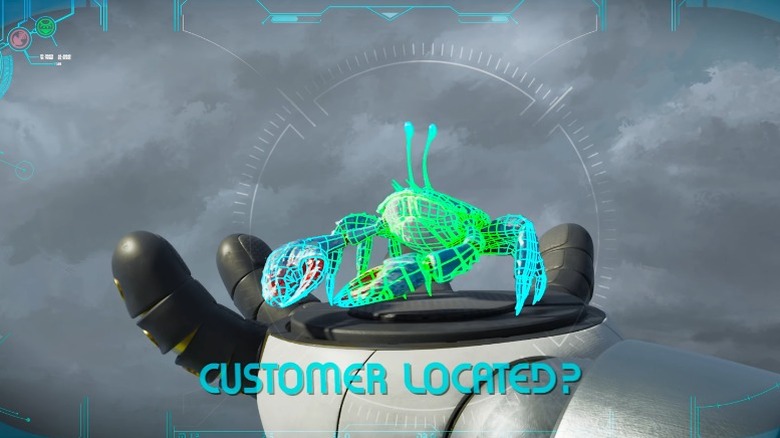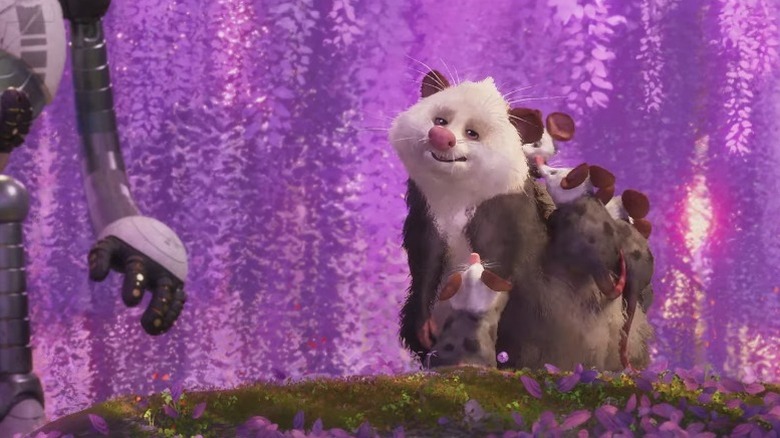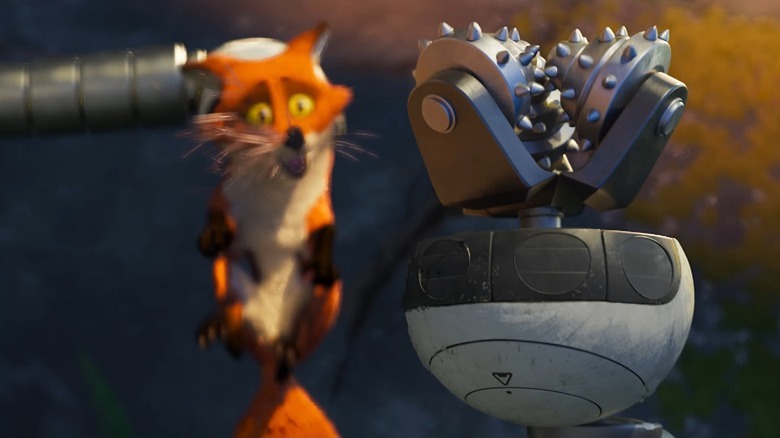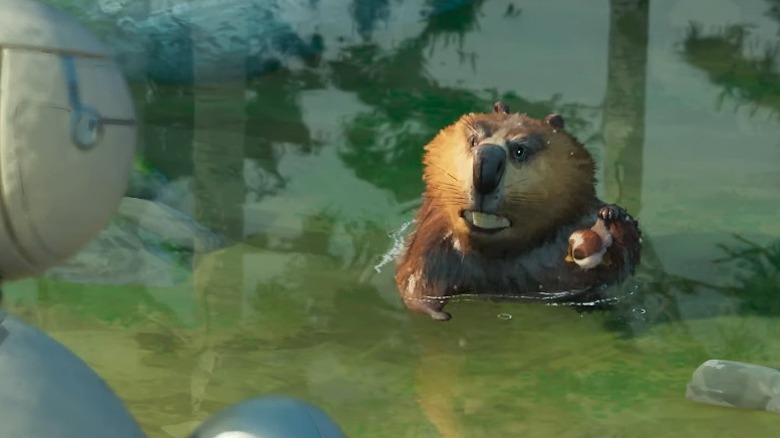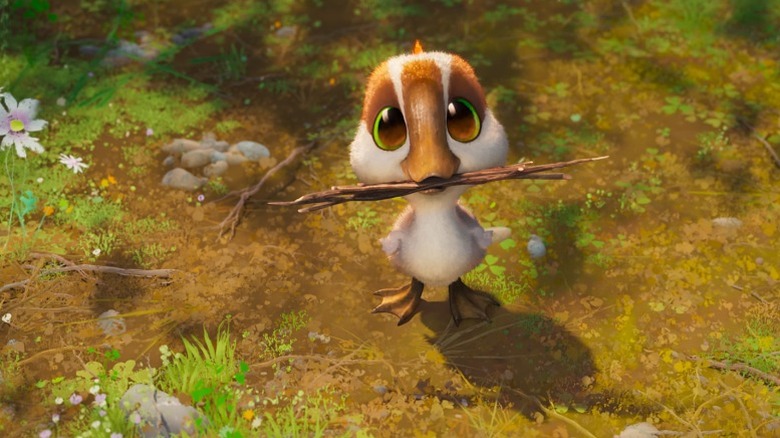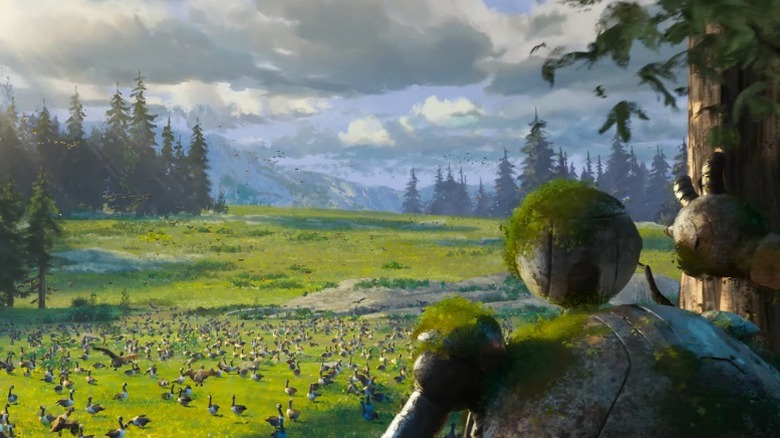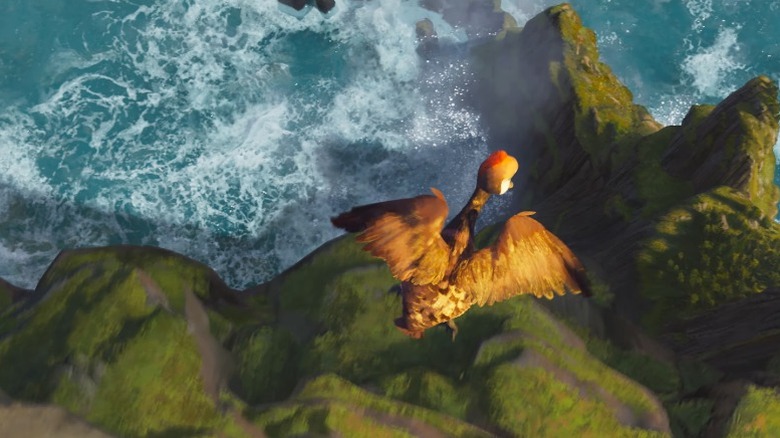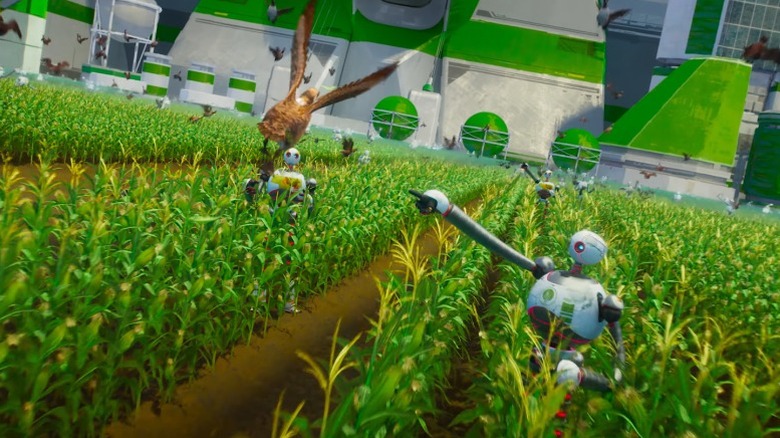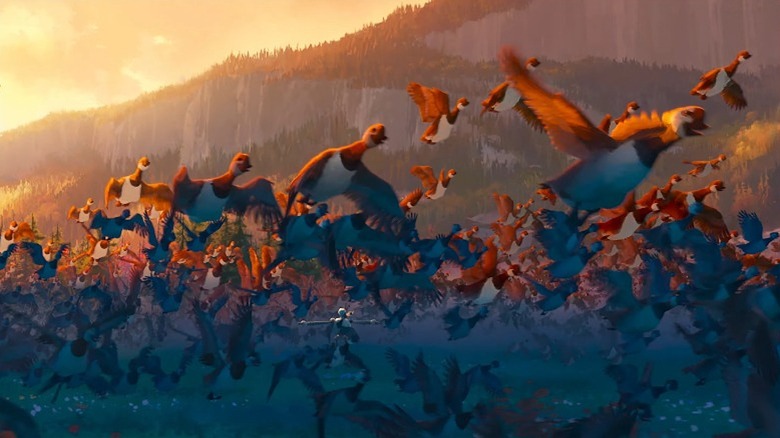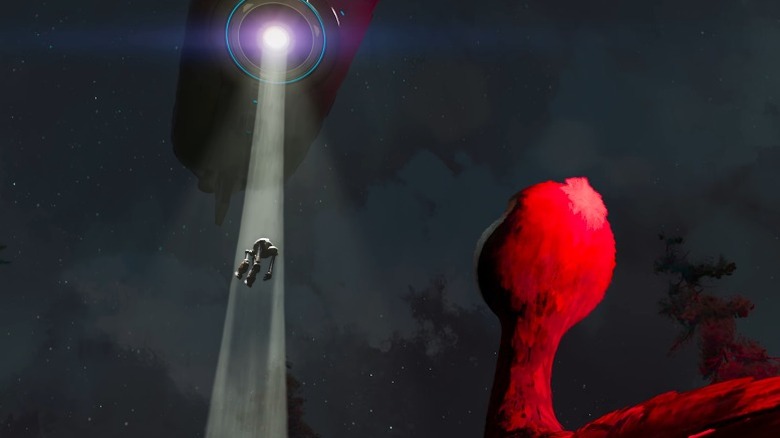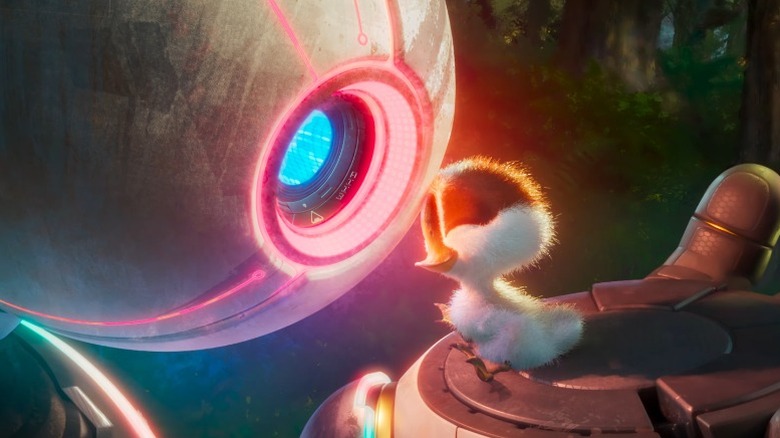Things Only Adults Notice In The Wild Robot
Directed by the great Chris Sanders, "The Wild Robot" is among the most enchanting DreamWorks Animation movies to be released in a very long time. Part of that can be attributed to the animation, which is imbued with a painterly, storybook quality, continuing the dazzling post-"Spider-Verse" trend in American big-studio animation of approaching CGI in new and interesting ways. Part of it is the minimalism and effective simplicity of the film, which is itself structured like a storybook, perhaps because it is based on one: The eponymous children's book series by Peter Brown.
Mostly, though, what makes "The Wild Robot" so interesting and affecting is its thematic investigation of the contrasts between the human-made and the organic, between programming and spontaneity, between efficiency and solidarity. The journey of ROZZUM 7134, aka Roz (Lupitia Nyong'o, most recently seen as Sam in "A Quiet Place: Day One"), truly feels like a journey, a transformative process from which she comes out fundamentally different. Most of the movie is pretty accessible and intelligible to kids, but some deeper elements of Roz's arc and the film's world-building may be better appreciated if you're an adult, and help cinch it's position as one of the best animated movies of 2024, so far.
At first, Roz is a satire of Silicon Valley smarminess
When ROZZUM 7134 initially arrives on the island, her behavior around the animals is marked by a comedic contrast between the harshness of nature and the robot's cheerful, upbeat tone and demeanor. Although a lot of that humor is pitched to children and adults alike, much of the fun in that early section of "The Wild Robot" gains an extra layer if you're a grown-up who's familiar with the 21st-century aesthetics of Silicon Valley's products and services.
In her factory-ready interactions with the island environment, Roz behaves rather like an avatar of tech-world frictionless design and commercial faux-helpfulness. Her smooth, metal body alone causes destruction and disturbance due to its clunking movement, loud noises, and sudden light flashes. She repeatedly offers help and assistance even though the animals don't need her, clearly trying to make herself useful while repeatedly extolling her own consumer benefits with a chirpy voice that implicitly says, "Please need me so we can make more money."
At one point, she starts handing out stickers with a code that offers a 10% discount on some product — meaning there'd still be more for a human to buy from Universal Dynamics even after purchasing her. She's essentially an intrusive ad and a parasitic free trial rolled into one; it's impossible to look at the image of various animals covered in discount stickers and not think of the many apps and services we have to deal with every day.
The movie doesn't sugarcoat nature's brutality
Life in the wild is a cruel, unforgiving thing. The vast majority of family-friendly animated films go at least a little light in their depiction of what it's like for wild animals trying to survive, which is understandable. It would probably not do most kids well to see killings, maimings, infanticides, deaths by starvation, and so on. "The Wild Robot" also spares viewers from the graphic violence, but otherwise, it's shockingly candid.
Very early on in the film, the animals surround Roz and ask if she intends to harm them; the second she says no, a moose headbutts her, and everyone breathes a sigh of relief at Roz's apparent demise. Having the entire cast pragmatically attempt to kill the protagonist in the first few minutes is not the kind of thing you see in most kid-friendly animated movies — but, of course, it's a 100% realistic and sensible thing for the animals to do in this context.
Later, the film keeps up the honesty by showing that Brightbill (Kit Connor), due to his disability, wouldn't have survived past childhood — and might not even have been born — if not for Roz interfering and going against the laws of survival by "artificially" protecting him. And that's not even getting into Pinktail (Catherine O'Hara, on a voice acting roll after her turn as Brook from "Elementals") and her joeys, who discuss and deal with death with complete nonchalance; Pinktail is even unfazed when one of her kids appears to die, and is actually disappointed when it turns out to be alive.
Roz is equipped with many deadly means of destruction
An important aspect of "The Wild Robot" and its storytelling is the fact that Roz is a completely, entirely, 100% benign robot. She specifically makes a point of telling the animals that her programming bans her from doing "deliberate harm to others." Even after she's gone beyond her programming, it's still never even remotely within question if she might hurt any of the other characters.
Which is not to say that she couldn't hurt the other characters. Although Roz doesn't actually use any of her tools and abilities for harm, the movie quietly demonstrates that she has immense lethal potential. For starters, of course, she's big and strong enough that she could easily kill any of the smaller animals on the island, and the fact that she's near-indestructible means that most of the larger ones would probably be no match for her, either. On top of that, when Fink (Pedro Pascal) steals the egg and hides in a fallen tree trunk, Roz uses a powerful buzzsaw to slash right through the trunk with ease, stopping just shy of the fox's face — the fear he shows in this moment says it all.
On top of that, Roz also has lasers, which she uses to boil water — ultimately dooming the poor crab that Fink shoves into the water puddle. It makes one wonder what kind of world would have use for a robot with so much destructive power ... or if ROZZUM units are more than just assistants.
Paddler faces the typical trials of an artist
Every animal on the island is subject to the hostility of others, but in the case of Paddler the beaver (Matt Berry), that hostility isn't merely physical: It's moral. The other animals mock and ostracize Paddler for his passion for carpentry and woodwork, questioning the value of spending so much of his time carving into trees and building wooden structures, failing to understand why he enjoys that work and its results so much. In other words, Paddler is an artist — and he faces many of the same trials as those who create art in the human world.
Just as artists are often judged and misunderstood for wanting to create beauty and hone their craft instead of opting for a more economically "useful" or "productive" field, the animals don't see why Beaver would go against the basic wildlife law of preserving energy and resources by focusing on things that are necessary for survival. And, just as society fails to understand the necessity and the importance of artists until art proves crucial to people's lives, the animals on the island only really understand Paddler's worth when they suddenly need his tree trunk to put out a fire. In that moment, they understand Paddler's vision; it becomes clear that things that may not immediately appear to be "useful" in a day-to-day sense may still be of great value just for the fact that nobody else has thought to do them. In the end, Paddler's freedom of spirit saves the day.
Roz's first big breach of protocol is deeply meaningful
The plot of "The Wild Robot" essentially consists of a series of small, meaningful gestures. Each one leads Roz to stray further and further from her initial programming, thereby transforming her from a mere machine to a subject with the capacity to think and feel independently. Early on, she's depicted as an algorithm trying to feel her way through an environment for which she was not prepared. Even her decision to raise Brightbill happens because of a "task assignment" given by Pinktail.
Things begin to change in one key moment. While building a shelter for herself and Brightbill, Roz is still following the "task" pretty stringently, with Fink's advice as a self-proclaimed "goose expert" guiding her. Then, Brightbill offers his help by bringing a tiny stick to stack up with the branches. Although Roz initially dismisses his "inefficient participation" because it will slow the process, she ultimately feels bad for him and lets him contribute "just once" — which turns into repeatedly lifting him up so he can add more and more tiny sticks to the shelter.
In that moment, by letting Brightbill "help" despite his ineffectiveness and accepting his inefficiency to humor him, Roz approaches humanity for the first time. She's no longer just trying to complete the task; she also cares about Brightbill on an emotional level and wants to see him happy. Not for nothing, but that moment also marks the first time she expresses a distinctly human emotion: annoyance.
Once Roz experiences love, she also experiences loss and loneliness
Becoming human is not easy. When Roz is just a machine carrying out tasks, her life is pretty existentially breezy. Any "problems" she comes across are only problems insofar as they're deterrents to completing certain tasks. The ones she can solve are then dealt with as efficiently as possible, while any problems that render a task impossible to complete will simply result in its cancellation. When she starts developing a soul, things get significantly more complicated.
The melancholy second-to-third act stretch of "The Wild Robot," in which Roz is wandering the island alone and trying to figure out what to do now that Brightbill has flown away with his peers, is colored by a realization that comes right on the heels of her burgeoning humanity. Now that she's able to love others, she also has something to lose. Caring that deeply about Brightbill means that she'll always be at risk of feeling hurt if anything should happen to him and that, when he's not around, she's going to miss him. The greatest of all human capacities — the capacity to love — makes her immediately vulnerable in a way that she wasn't before.
At the same time, now that Roz has experienced love, she begins to crave connections with other creatures. Suddenly, it's not enough for her to just wander about the island waiting to be given a task or be retrieved by Universal Dynamics. Love begets a desire for love.
The movie takes place on an Earth with higher sea levels
"The Wild Robot" largely plays coy about its post-climate catastrophe future Earth setting, but we do get at least one big piece of information. As the geese migrate, there is a shot of them flying over the Golden Gate Bridge, and it's completely submerged. The sea level has risen so much, in fact, that an entire whale can be seen swimming over the iconic San Francisco landmark.
It's a consensus among climate scientists that sea levels around the globe are rising at an alarming rate due to the melting of the ice caps, and are likely to rise even higher if current carbon emission trends are not dramatically reversed. Absolute worst-case scenario projections currently indicate that the seas could rise by up to 72 feet (22 meters) by 2300 if global warming reaches 5°C — which would be enough to wipe out entire coastal cities, but not quite enough to cover the Golden Gate Bridge, which stands 220 feet above the Golden Gate strait. The sea would only reach that height if all the ice on both the North and South Pole were to completely melt.
In other words, "The Wild Robot" seems to suggest a future in which humans have screwed things up so badly that there are no ice caps left. In that terrifying scenario, some entire countries would be submerged, in addition to virtually all coastal cities on the planet. Sure explains the greenhouses and the general absence of humans; this is pretty much a post-apocalyptic movie.
The greenhouse decontamination protocol evinces a humankind that still hasn't learned
In the future of "The Wild Robot," it stands to reason that humanity — or at least the people in power — completely failed to establish any sort of harmonious relationship with nature, with Earth, and with each other. In parallel, humans also seemingly developed technology sophisticated enough to maintain not only a sentient robot like Roz, but an entire, hyper-advanced greenhouse city. But, as revealed by the glimpse we get into the city, old habits die hard.
The defensive protocol that gets activated when the geese enter the greenhouse demonstrates that humans — or, again, at least the people in power — still don't know how to interact with nature in a harmonious manner or respond to problems in a non-belligerent way. Never mind the fact that the geese enter the greenhouse way too easily and that the humans should have already implemented a way to keep wildlife out, or at least deal with it peacefully; the entire protocol is farcical on its face.
In aiming so much firepower at the geese, not only do the greenhouse's defenses fail to get rid of the birds, but they also cause an enormous amount of destruction and harm to the greenhouse itself, and quite possibly to the people in it. Even as they've sequestered themselves in a safe bubble, away from the destruction they've wreaked on the world, humans are still a careless, flighty, trigger-happy bunch, prone to thinking that technology makes them invulnerable to nature.
The film evokes the specter of climate change without quite facing it head-on
For all its surprising frankness, "The Wild Robot" is still a kids' movie. And, as such, there's a limit to how dark it gets. The "nature is brutal" slant, for one thing, doesn't stop the ending of "The Wild Robot" from presenting a somewhat fantastical scenario in which the animals get past their own programming and learn to get along, competition for finite resources notwithstanding. The same is true of the film's climate change angle. It's pretty bold for a family-oriented animation, but without quite going as far as it could.
If "The Wild Robot" did go all the way — if it actually reckoned with the darker scientific possibilities and likelihoods associated with climate change — it would have to acknowledge that most biomes and ecosystems would not come out unscathed once humans were gone, most likely including the island.
Despite the "humans are a blight and the Earth will be better off without us" takes you see going around sometimes, a cataclysmic climate scenario capable of rising sea levels by hundreds of feet would also dramatically impact wildlife. In this case, the higher temperatures alone would make life impossible for many of the animals seen in the movie. "The Wild Robot" critiques the Earth's destruction, but still falls back on the kind of "bucolic humanless Earth" imagery that sometimes renders misanthropes more or less unfazed about climate change, maybe because the reality of it — that, if humans die, we take a lot of nature with us — is just so darn scary.
Universal Dynamics is most likely a weapons manufacturer
One of the most quietly enigmatic things about "The Wild Robot" is the fact that Universal Dynamics expends so many resources, so much money, and so much effort on the task of retrieving Roz — a ROZZUM unit that is hard to locate, does not want to be retrieved and will resist it actively, and can easily be replaced in any of its functions by an identical ROZZUM unit. Equally enigmatic is the fact that Universal Dynamics seemingly has access to some sort of military-grade control panel with which it can track down its units all over the world.
This points to two things: First, it's a company with a lot of money. Second, it's got vested interests in Roz's capture that go beyond tending to basic consumer needs. No possible assistant robot applications could be augmented enough by Roz's forest experiences to justify the massive spending to capture her. What companies build advanced machines and make a ton of money but don't sell to casual consumers? Weapons manufacturing companies.
That's the most viable explanation for Roz's helpful yet potentially destructive design — ROZZUM units may well be equipped for military action in addition to their assistant services. It would also explain why Universal Dynamics is so desperate to retrieve her and mine her for information. A ROZZUM upgraded with Roz's experiences would not be all that much more useful for someone who just wants to do gardening and banking. But for someone who wants to hurt and destroy more efficiently? She's a gold mine.
What cinches Roz's humanity is her choice to stick to a purpose
At its heart, "The Wild Robot" is a story about what it means to have a purpose. The thing that differentiates ROZZUM unit 7134 from Roz, the thing that sets her machine self apart from her human self, is the way in which she begins to wrestle with that question. When she's simply following protocols, Roz doesn't wrestle with her purpose at all, because she's been designed to execute whatever tasks she's been given.
The evolved Roz, meanwhile, doesn't need to follow any tasks; she is now able to choose whether to obey her factory directives or not. Past a certain point, she isn't helping Brightbill because there is an externally-handed "reason" to devote herself to that purpose; she's helping him because she wants to help him, and chooses to commit to that. She even explicitly tells Brightbill that she kept quiet about being responsible for his family's death because she "needed a task." She embraces raising and parenting Brightbill in order to have a purpose at all; a purpose that is given to her by herself.
That moment — the moment in which she chooses to stick to a purpose — is the moment in which Roz achieves true psychological depth. That's what life is: we give it meaning ourselves and commit to that meaning. Purpose is not an external directive; it's something we invent continuously. Not since "WALL-E" has a robot taught us so much about our own humanity.
